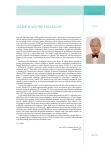PROGNOSTIC VALUE OF p53, Ki-67 EXPRESSION IN THE UROTHELIAL CARCINOMA TISSUE AND URINARY BLADDER NONTUMOR MUCOSA
Authors:
Viktor Soukup 1; Marko Babjuk 1; Jaroslava Dušková 2; Michael Pešl 1; Monika Szakácsová 1; Libor Zámečník 1; Jan Dvořáček 1; Ctibor Povýšil 2
Authors‘ workplace:
Katedra urologie IPVZ, Urologická klinika 1. LF UK a VFN, Praha
1; Patologický ústav 1. LF UK a VFN, Praha
2
Published in:
Ces Urol 2009; 13(2): 161-167
Category:
Original article
Overview
Aim:
The aim of the prospective study was to assess the prognostic value of p53, Ki-67 expression level in the urothelial carcinoma tissue and in the samples of urinary bladder non-tumor mucosa.
Material and methods:
Forty eight patients with first history of Ta, T1 urinary bladder carcinoma were enrolled into the study. They were all followed for 31,3 month at average. Primary antibodies (Imunotech/ DAKO) were used to detect p53 and Ki-67 positivity. The expression was evaluated semi quantitatively and expressed as HSCORE, where HSCORE = Σpi (i + 1), in which I is one of the four positivity grades, Pi stands for the positive nuclei percentage. All patients were included into the follow-up program. The results were evaluated in the statistical system SAS (Cary, USA).
Results:
The tumor recurrence was detected in 21 patients, and tumor progression in four patients. The average p53 expression value in the tumor samples was 139.3, in the samples of non-tumor mucosa was 118.2. The average Ki-67 values were 126.2 in the tumor samples and 107.6 in the non tumor mucosa. P53 positivity in the tumor and non-tumor mucosa correlated significantly (p = 0.0019), nevertheless, not the same relation was found for Ki-67. The level of expression Ki-67 in non tumor musoca correlated significantly with recurrence-free interval (p = 0.023), the cut-off level was calculated 127.66. Ki-67 and p53 expression in the tumor tissue were significantly related to the tumor grade (p = 0.003 and p = 0.004, resp.). The level of Ki-67 expression in non-tumor mucosa and tumor multiplicity had independent prognostic value in the relation to the cancer recurrence.
Conclusion:
The level of p53, Ki-67 expression in tumor tissue correlated with those levels in non-tumor mucosa. The level of Ki-67 expression in nontumor mucosa brings independent prognostic information in relation to the cancer recurrence and could be the cause of urinary bladder urothelial carcinoma multiplicity. Further research has to be done for the final assessment.
Key words:
urinary bladder urothelial carcinoma, nontumor mucosa, p53, Ki-67.
Sources
1. Lamm DL. Long-term results of intravesical therapy for superficial bladder cancer. Urol Clin North Am 1992; 19: 573–580.
2. Heney NM, Ahmed S, Flanaghan MJ, Frable W, Corder MP, Hafermann MD, Hawkins IR. Superficial bladder cancer: Progression and recurrence. J Urol 1983; 130: 1083–1086.
3. Holmang S, Hedelin H, Anderström C, et al. Recurrence and progression in low grade papillary urothelial tumors. J Urol 1999; 162: 702–707.
4. Sidransky D, Frost P, Von Eschenbach A, et al. Clonal origin bladder cancer. N Engl J Med 1992; 326, 737–740.
5. Takahashi T, Habuchi T, Kakehi Y, et al. Clonal and chronological genetic analysis of multifocal cancers of the bladder and upper urinary tract. Cancer Res 1998; 58: 5835–5841.
6. Fadl-Elmula I, Gorunova L, Mandahl N, et al. Cytogenetic monoclonality in multifocal uroepithelial carcinomas: evidence of intraluminal tumor seeding. Br J Cancer 1999; 81: 6–12.
7. Heney NM, Daly J, Prout GR, et al. Biopsy of apparently normal urothelium in patients with bladder carcinoma. J Urol 1978; 120: 559–560.
8. Igawa M, Urakami S, Shirakawa H, et al. A mapping of histology and cell proliferation in human bladder cancer: an immunohistochemical study. Hiroshima J Med Sci 1995; 44: 93–97.
9. Koss LG. Mapping of the urinary bladder: its impact on the concepts of bladder cancer. Hum Pathol 1979; 10: 533–548.
10. Stoehr R, Zietz S, Burger M, et al. Deletions of chromosomes 9 and 8p in histologically normal urothelium of patients with bladder cancer. Eur Urol 2005; 47: 58–63.
11. Sun W, Zhang PL, Herrera AG. p53 Protein and Ki–67 overexpression in urothelial dysplasia of bladder. Appl Immunohistochem Mol Morphol 2002; 10(4): 327–331.
12. Pycha A, Mian C, Hofbauer J, et al. Multifocality of transitional cell carcinoma results from genetic instability of entire transitional epithelium. Urology 1999; 53: 92–97.
13. Spruck CH III, Ohneseit PF, Gonzales-Zulueta M, et al. Two molecular pathways to transitional cell carcinoma of the bladder. Cancer Res 1994; 54: 784–788.
14. Sidransky D, Von Eschenbach A, Tsai YC, et al. Identification of p53 gene mutations in bladder cancers and urine samples. Science 1991; 252: 706–709.
15. Dalbaghi G, Presti JC, Reuter VE, et al. Molecular genetic alterations of chromosome 17 and p53 nuclear overexpression in human bladder cancer. Diagn Mol Pathol 1993; 2: 4–13.
16. Soukup V, Babjuk M, Dušková J, Pešl M, Szakázcová M, Zámečník L, Dvořáček J. P53 pozitivita v nenádorové sliznici u pacientů s povrchovým uroteliálním karcinomem močového měchýře. Čas Lék čes 2007; 146: 63–67.
Labels
Paediatric urologist Nephrology UrologyArticle was published in
Czech Urology

2009 Issue 2
Most read in this issue
- ATYPICAL TORSION OF THE TESTICULAR APPENDIX
- PROGNOSTIC VALUE OF p53, Ki-67 EXPRESSION IN THE UROTHELIAL CARCINOMA TISSUE AND URINARY BLADDER NONTUMOR MUCOSA
- DEVELOPMENT AND CLINICAL EVALUATION OF NEW DRUGS
- OUR EARLY EXPERIENCE WITH ROBOTIC-ASSISTED LAPAROSCOPIC RADICAL PROSTATECTOMY - FIRST 153 CASES
